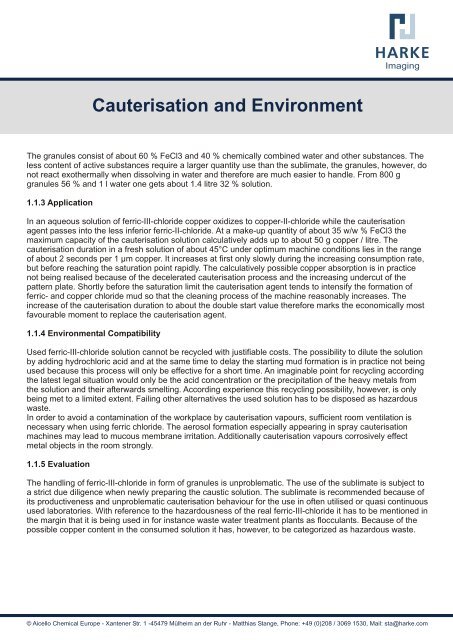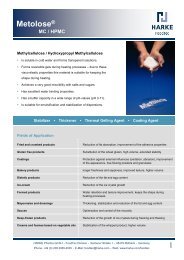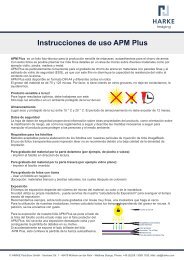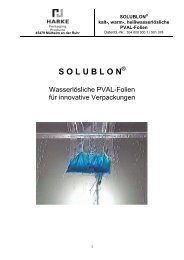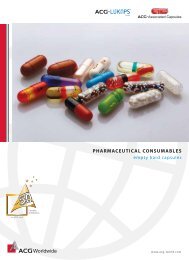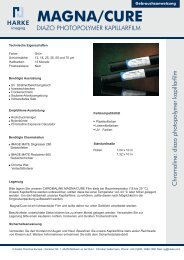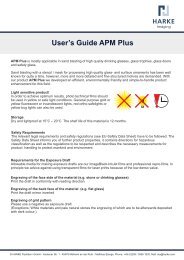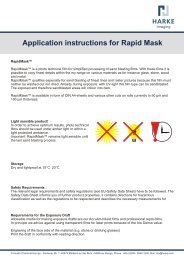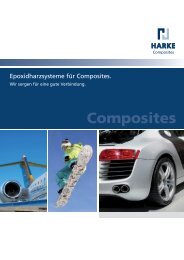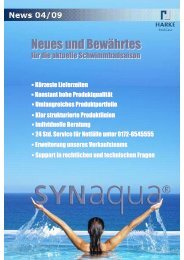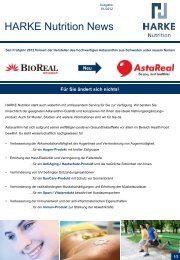Cauterisation and Environment - HARKE Group
Cauterisation and Environment - HARKE Group
Cauterisation and Environment - HARKE Group
You also want an ePaper? Increase the reach of your titles
YUMPU automatically turns print PDFs into web optimized ePapers that Google loves.
Imaging<br />
The granules consist of about 60 % FeCl3 <strong>and</strong> 40 % chemically combined water <strong>and</strong> other substances. The<br />
less content of active substances require a larger quantity use than the sublimate, the granules, however, do<br />
not react exothermally when dissolving in water <strong>and</strong> therefore are much easier to h<strong>and</strong>le. From 800 g<br />
granules 56 % <strong>and</strong> 1 l water one gets about 1.4 litre 32 % solution.<br />
1.1.3 Application<br />
In an aqueous solution of ferric-III-chloride copper oxidizes to copper-II-chloride while the cauterisation<br />
agent passes into the less inferior ferric-II-chloride. At a make-up quantity of about 35 w/w % FeCl3 the<br />
maximum capacity of the cauterisation solution calculatively adds up to about 50 g copper / litre. The<br />
cauterisation duration in a fresh solution of about 45°C under optimum machine conditions lies in the range<br />
of about 2 seconds per 1 µm copper. It increases at first only slowly during the increasing consumption rate,<br />
but before reaching the saturation point rapidly. The calculatively possible copper absorption is in practice<br />
not being realised because of the decelerated cauterisation process <strong>and</strong> the increasing undercut of the<br />
pattern plate. Shortly before the saturation limit the cauterisation agent tends to intensify the formation of<br />
ferric- <strong>and</strong> copper chloride mud so that the cleaning process of the machine reasonably increases. The<br />
increase of the cauterisation duration to about the double start value therefore marks the economically most<br />
favourable moment to replace the cauterisation agent.<br />
1.1.4 <strong>Environment</strong>al Compatibility<br />
Used ferric-III-chloride solution cannot be recycled with justifiable costs. The possibility to dilute the solution<br />
by adding hydrochloric acid <strong>and</strong> at the same time to delay the starting mud formation is in practice not being<br />
used because this process will only be effective for a short time. An imaginable point for recycling according<br />
the latest legal situation would only be the acid concentration or the precipitation of the heavy metals from<br />
the solution <strong>and</strong> their afterwards smelting. According experience this recycling possibility, however, is only<br />
being met to a limited extent. Failing other alternatives the used solution has to be disposed as hazardous<br />
waste.<br />
In order to avoid a contamination of the workplace by cauterisation vapours, sufficient room ventilation is<br />
necessary when using ferric chloride. The aerosol formation especially appearing in spray cauterisation<br />
machines may lead to mucous membrane irritation. Additionally cauterisation vapours corrosively effect<br />
metal objects in the room strongly.<br />
1.1.5 Evaluation<br />
<strong>Cauterisation</strong> <strong>and</strong> <strong>Environment</strong><br />
The h<strong>and</strong>ling of ferric-III-chloride in form of granules is unproblematic. The use of the sublimate is subject to<br />
a strict due diligence when newly preparing the caustic solution. The sublimate is recommended because of<br />
its productiveness <strong>and</strong> unproblematic cauterisation behaviour for the use in often utilised or quasi continuous<br />
used laboratories. With reference to the hazardousness of the real ferric-III-chloride it has to be mentioned in<br />
the margin that it is being used in for instance waste water treatment plants as flocculants. Because of the<br />
possible copper content in the consumed solution it has, however, to be categorized as hazardous waste.<br />
© Aicello Chemical Europe - Xantener Str. 1 -45479 Mülheim an der Ruhr - Matthias Stange, Phone: +49 (0)208 / 3069 1530, Mail: sta@harke.com


